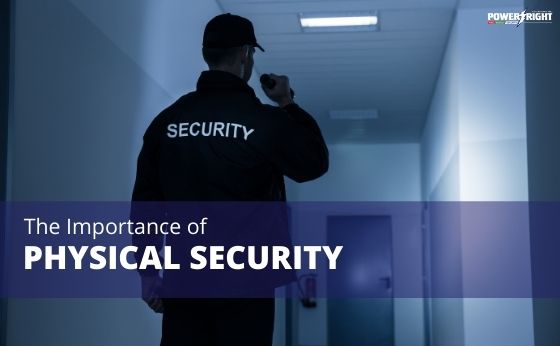
Digital platforms dominate the world these days as practically any business depends on IT for information exchange, monetary transactions and other business operations.
Thus, digital security seems to be more important, but it is impossible to protect your digital assets without safeguarding your physical property and employees.
Physical security means protecting business assets (property, employees, IT infrastructure etc.) from any harm or damage. The damage can be caused by such physical events as natural disasters, floods, fires, and crimes.
Physical security consists of three parts, namely video surveillance, access control, and recovery testing.
CCTV systems together with smoke detectors and anti-intrusion sensors can significantly improve business security by ensuring regular and consistent monitoring of every part of your organization.
Access control consists of physical obstacles placed in the way of potential intruders or threats. It is critical to fortify such locations as data centres and servers against any attacks or natural disasters.
You can do so by placing physical fences, locks and some access control solutions, for example, biometric identification systems and access cards.
Regular testing of recovery procedures and policies guarantees safety and reduces the recovery time in case of an emergency.
Every business depends on digital technologies and possesses digital assets, such as business data, documents, and material resources. There are some physical aspects of the general security protocol that can provide security of your digital assets. So, physical security helps to:
Restricting access to boosts security by allowing some particular classes of employees limited access to the organizational infrastructure.
Physical security measures are multilayered. Thus, even if one solution (such as access control system) fails, there are others (such as video surveillance) to protect your digital and physical assets.
Cybersecurity measures are invisible, whereas the advantage of physical security measures is that they are visible. It helps to deter malicious acts and provide a sense of security and openness in your staff.
Real-time notifications that locate the breach help to react faster and implement countermeasures timely.
Depending on the place of origin, physical threats can be:
Internal threats originate within the company. They can be careless employees, security team mistakes or flood in server rooms and power supply failure.
These threats come from outside the company. They can be attacks by outside parties or even natural disasters as lightning strikes and fires.
One of the most common threats is theft. In this day and age of small digital devices, we need to be careful about our resources, as it is easy to take them away. Theft can be brought about by external as well as internal factors.
Hence, any business should utilize CCTV systems, RFID-enabled devices to make sure no one does any harmful actions.
What are the measures to ensure a decent level of physical security? Here are some universal measures which can safeguard your digital infrastructure.
Hiring more security workers helps to protect entrances and exits so that no unauthorized exit/entry occurs. Moreover, extra personnel give peace of mind to your workers and will deter those with malicious intent.
Your security staff should know and follow your organizational requirements and also be fitted with modern equipment.
When your monitoring system is well maintained and updated, it is much more efficient in preventing potential dangers. First of all, surveillance cameras should be located in strategic places offering maximum visibility.
Moreover, make use of an automated alert system. It notifies the right staff member of any suspicious movement or unauthorized intrusion.
Easy access to premises can compromise your digital assets. Consequently, restricting access to some parts of your premises can guarantee the safety of your digital data and infrastructure.
There are numerous ways to allow only the authorized personnel to your premises: ID tags, security check, and access codes.
Even the best security system will not work if your employees are not familiar with their duties, responsibilities and security protocols.
Make sure your staff goes through the training to know what to do in case of physical intrusions and natural cataclysms.
If you still use traditional servers, which are soft-targets for perpetrators, make sure that server rooms are locked at all times. Access to such rooms should be restricted.
Network devices are are prime targets for hackers. Thus, keep them under lock and key as well.
If a breach happens, you need to find who is responsible. In such cases, CCTV systems data can be of use. Your IT assets have to be monitored around the clock.
Your valuable business data remains safe if there are no unmanned workstations in your company. If there are, make certain the access to them is restricted.
Surprisingly printers can be of interest of hackers as it is possible to make reprints of cached files with some sensitive information. Bolt the printers to the platform, keep them in a secured location and place the camera above to record the activity around it.
Any portable devices, as laptops and tablets, should be protected in the workplace. It is possible to use cable locks, motion sensors and locked drawers. Security staff should be trained to frisk employees and visitors for any devices they take out or bring in the office.
Just like network resources and servers, backups should be kept behind lock and key. As a matter of fact, the best way to protect backups is to store them in secure locations off-site.
Never allow employees to use their own storage devices in the workplace. They can make a copy of backup files and take them outside.
Physical security is not an independent concept. It is essential for every organization, and it also can be one of the key components of the cybersecurity plan. Creating a secured digital ecosystem is impossible without ensuring the physical protection of premises and devices.
There are multiple ways to protect your business against physical threats: fortification of essential locations, multiple backups, CCTV systems usage, restricting access to sensitive data and strategic places etc.